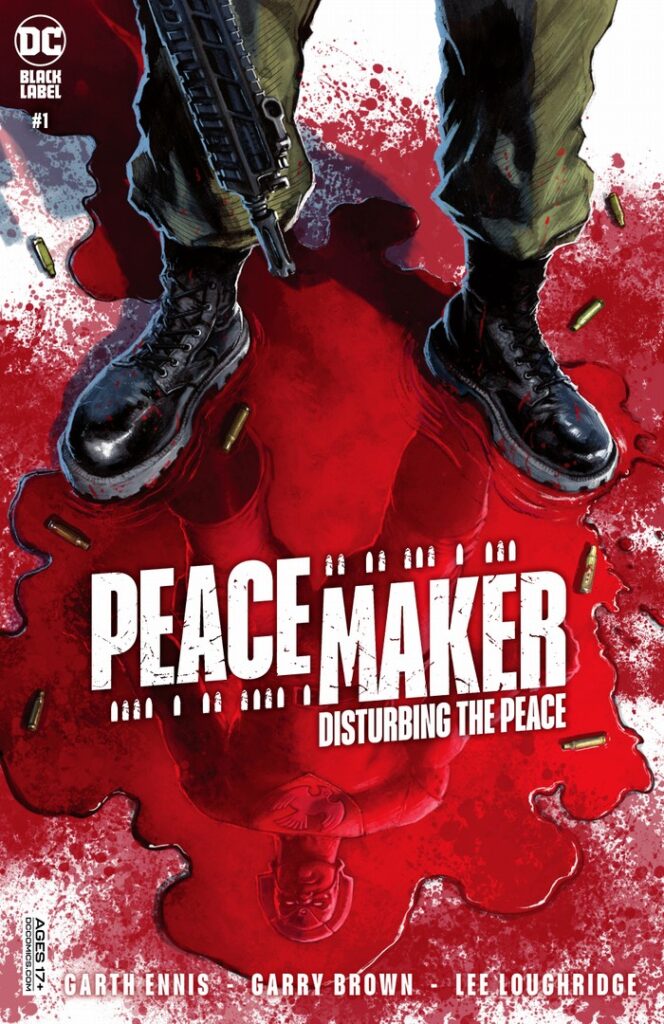Comics Corner – Has DC failed LGBTQ+ readers with Peacemaker?
“Synergy” is often an awkward concept for media crossovers or adaptations, and especially so for comics. For publishers, the chance to bring often decades-old properties to the big screen or video games can expose those characters and stories to an audience often magnitudes of order larger than the contemporary comic book readership, with the hope being that a few of those will find their way to a comic book store or bookshop. The benefit to filmmakers is having a pool of ready-made concepts to bring to life, which come with a built-in ‘seed’ audience. However, the trick is that the characters have to be recognisable to long-time fans on screen, and remain approachable in print for newcomers drawn in by the newer outing.
Staying loyal to the source material when adapting a comic book to the screen can sometimes work – Iron Man made it to the big screen largely unchanged from his roots, launching the modern Marvel Cinematic Universe in the process, while both director Christopher Nolan’s Dark Knight trilogy and Tim Burton’s 1989 Batman authentically capture different aspects of the Caped Crusader, showing the versatility of the character.
At the other end of the spectrum, you have cinematic abominations like the 2004 Catwoman film. Not only did it present an unrecognisable version of the character for viewers going in – Patience Phillips, a woman resurrected with feline powers by the Egyptian goddess Bast, rather than the unpowered master thief Selina Kyle – but anyone who did happen to like that version of the character would find no further stories featuring her to be found in the comics.
Somewhere in the middle is the early X-Men films – mostly recognisable in personalities and powers on screen, but boasting a Matrix-inspired black leather wardrobe that fed back into the comics. The result was a solid few years of Marvel publishing X-Men stories with the once-colourful heroes draped in “realistic” costumes.

All of which is a long preamble that brings us to Peacemaker. Debuting on the big screen in director James Gunn’s 2021 supervillain romp The Suicide Squad, played by John Cena, the character was the unlikely recipient of his own spinoff TV series, also helmed by Gunn. Set in the wake of the film, the eight-episode Peacemaker show – which recently finished airing on HBO Max in the US, but at time of writing currently has no broadcast date in the UK – follows the titular character as part of an unlikely black-ops squad tackling an alien invasion.
It also established the leading anti-hero as bi- or pansexual. The exact label is never given – Gunn says, in an interview with Empire Magazine, that Peacemaker is “not straight”, and credits Cena with turning the character “into this hyper-sexualised dude that is open to anything sexually” – but there are several moments across the season that confirm his not-straightness. In one episode, Peacemaker suggests having sex with colleague Emilia Harcourt (Jennifer Holland), saying he’s not had sex for four years while he was in prison, before qualifying himself to “with a woman”. Elsewhere, Peacemaker is seen in bed with fellow crimefighter Vigilante (Freddie Stroma) and a woman named Amber, clearly in the aftermath of a threesome.
However, these moments are both largely played for laughs, and fairly outdated ones too – the ancient trope of imprisoned men being left ‘without options’, or that threesomes ‘don’t count’. It’s not until the seventh episode, where Peacemaker confronts his father – a white supremacist and leader of a neo-Nazi gang, who goes by the name White Dragon – that there’s any spoken confirmation.
During the conflict, Peacemaker’s father says “I knew you was unclean when you was born, and even more so when … you slept with the whores of polluted blood, and men!” While a racist supervillain isn’t exactly a reliable narrator, it is the first indication that Peacemaker has any kind of pattern of same-sex attraction or behaviour.
Yet so far, it’s a pattern that isn’t mirrored in the character’s comic book interpretation. In fact, publisher DC has gone in a very different direction with the character, with the only Peacemaker starring comic currently available for readers to buy being a one-shot that gives the character a revamped origin, one that frames him closer to being a version of Marvel’s Punisher than the quirky, troubled, figure of Gunn’s film and TV show.
Which brings us back to synergy. Gunn’s interpretation of Peacemaker was, aside from a gloriously accurate costume and the civilian identity of Christopher Smith, already quite a departure for the character. Originally published by Charlton Comics, Peacemaker first appeared in Fightin’ 5 #40 in 1966, created by Joe Gill and Pat Boyette. A US diplomat and pacifist, the original version of Peacemaker was framed as “a man who loves peace so much that he is willing to fight for it!”. A genius scientist and engineer, Smith reluctantly used weapons and technology of his own creation to enact violence to prevent greater conflicts from erupting on the world stage.

Eventually, DC would acquire many of Charlton’s characters, including Blue Beetle, Captain Atom, and Judomaster, the latter of whom appears in the Peacemaker TV show, played by Nhut Le. However, while modified versions of the heroes would form the basis of the cast of Watchmen – with Peacemaker being the basis for The Comedian – and both Captain Atom and Blue Beetle became major players in the DC Universe in their own rights, Peacemaker largely slipped from view.
A four-issue Peacemaker mini-series was published in 1988, written by Paul Kupperberg with art by Tod Smith and Pablo Marcus, which revamped the character’s origin – making him the son of a Nazi war criminal, a background Gunn would tweak for the TV show – while also amping up Smith’s mission to a more murderous “I’ll kill to keep the peace!”. Beyond that series, the character was seldom seen – an unnamed Peacemaker appeared in an issue of Justice League International, a new version named Mitchell Black showed up in a miniseries called The L.A.W. (which gathered the former Charlton heroes into a new, short-lived team), and the Christopher Smith version appeared in the modern Blue Beetle series. There was also a Peacemaker back-up in the 2019 Inferior Five miniseries, but production delays saw the 12-issue run cut to six, leaving plotlines unresolved. None of these iterations of the character displayed any hint of being anything other than a straight white male though.
More recently, the Christopher Smith version of Peacemaker has been appearing in the current Suicide Squad series by Robbie Thompson, Eduardo Pansica, et al – for some synergy with Gunn’s movie, at least – albeit with zero focus on his personal life and no space for relationships with anyone of any gender. Crossover appearances in The Swamp Thing have given some development on his role within the Suicide Squad, but by necessity of being a guest character, no personal development. In either title, the current comic book version of Peacemaker is a single-minded killer, sociopathically obsessed with his murderous interpretation of how to bring about peace. He is effectively devoid of humanity, let alone sexuality, and the aforementioned one-shot – Peacemaker: Disturbing the Peace, written by Garth Ennis with art by Garry Brown – doubles down on that, giving Smith yet another origin and a coldly analytical personality to match.

So, synergy then. Has DC missed a trick by not having a version of Peacemaker in the comics that would better reflect the version onscreen? While that iteration is still a killer with an utterly warped sense of right and wrong, Gunn’s scripting and Cena’s performance give him some sympathetic traits, making him a redeemable lunkhead while also establishing him as the DC Extended Universe’s first queer male character. Yet much like the 2004 version of Catwoman, anyone who likes that incarnation of the character will be unable to find him in the comics. In his place, there’s only a sociopathic killer that it would be hard to revamp into anything close to Cena’s take – and even if DC tried to massage the print version of the character into something closer to the screen’s, would LGBTQ+ readers want a bi- or pansexual identity layered onto the damaged, merciless slaughterer of Ennis and Thompson’s takes?
We’re not sure there’s an easy answer, especially since the contemporary interpretation of Peacemaker in the comics is already “reverse influenced” by his own sadistic mirror from the far more successful Watchmen. Yet with the Peacemaker TV show already renewed for a second season, that interpretation of the character is cementing itself as the version fans will know. With the comic version currently unrecognisable in any respect aside from the costume, perhaps the easiest solution would be to revamp Peacemaker during DC’s next inevitable continuity reset, and bring the chaotic bisexual energy of Gunn and Cena’s version to the comics.







